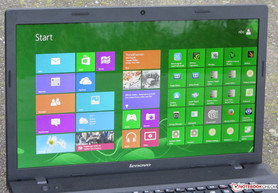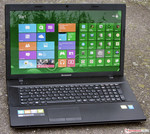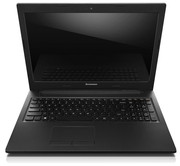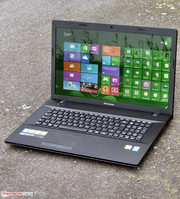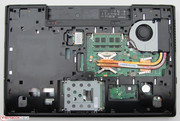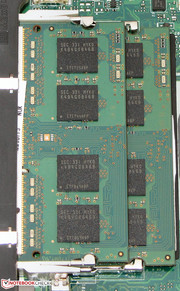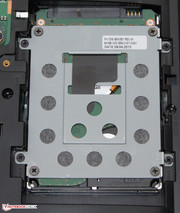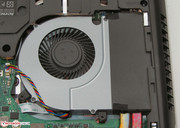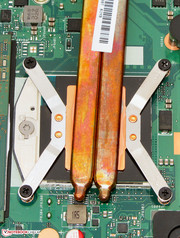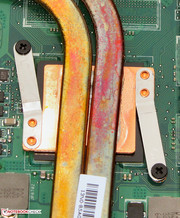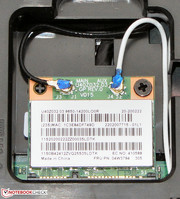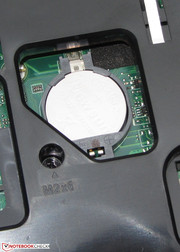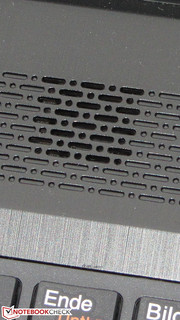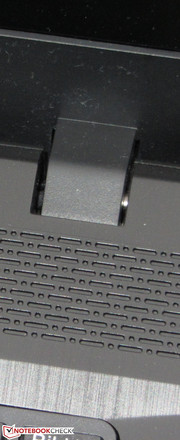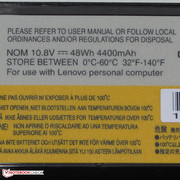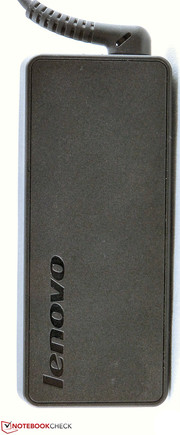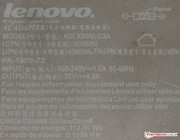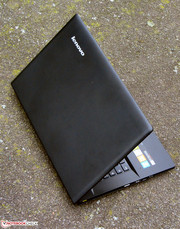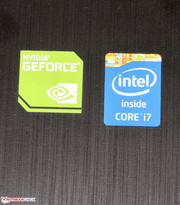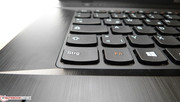Review Lenovo G710 59397112 Notebook

For the original German review, see here.
Lenovo offers 17.3-inch notebooks with its G710 series, which is supposed to satisfy a large audience. You can choose between simple notebooks for text editing and web browsing or powerful devices with a Core i7 processor and a GeForce GPU. Depending on the hardware equipment, the prices of the various configurations are between 400 and 800 Euros (~$540 and ~$1080). We just reviewed a device from the predecessor-series Lenovo G700 (Pentium 2020M, HD Graphics (Ivy Bridge)) a couple of months ago. The biggest change of the G710 compared to the G700 is the replacement of the Ivy Bridge CPUs with Haswell models. Is the G710 a good notebook?
We use the HP Pavilion 17-e054sg (AMD A10-5750M, Radeon HD 8650G + HD 8670M Dual Graphics) and Asus F75VC-TY088H (Core i3-2370M, GeForce GT 720M) for comparison, but the latter is not available anymore in our review configuration. Instead of a Sandy Bridge processor (Core i3-2370M), the notebook is now equipped with an Ivy Bridge CPU (Core i3-3110M F75VC-TY142H; around 500 Euros, ~$675).
Lenovo uses the same chassis for the G710 as it did for the G700. We will therefore not cover the case, the connectivity, the input devices or the speakers in this review. The according information can be found in the review of the G700.
Connectivity
Operating System
Our review unit uses FreeDos as the operating system. However, the installation of a current Windows OS is no problem. We recommend Windows 8 or 8.1 since Lenovo provides drivers for these operating systems and the scope of delivery even includes a DVD with drivers for Windows 8. Users can use Windows 7 as well, but you will have to search for the drivers yourself. We tried to install Windows 7 SP1: Windows 7 does not provide the drivers for the two GPUs, the chipset, the WLAN module, Ethernet or USB 3.0, but all drivers are available.
- We were able to use the Ethernet port with the driver from the provided DVD.
- The WLAN module worked with a driver from Lenovo, even though it was intended for another device. One note: The driver DVD shows that the G710-series can also use WLAN modules from Atheros or Intel. We recommend you try the drivers from the DVD first in these cases. Otherwise you can search on Intel's website or on the website Atheros.cz, respectively.
- Chipset driver, USB 3.0 driver and the driver for the Intel GPU can be found on Intel's website.
- Nvidia provides the latest driver for the GeForce GPU.
- The Bluetooth chip from our review unit is - similar to the WLAN module - from Broadcom. We could use the driver from the DVD, however, the usual installation only worked with Windows 8, so we had to install the driver manually from the Device Manager. Similar to the WLAN module there is also the chance that the Bluetooth chip is provided by Intel or Atheros; the approach is therefore similar.
- The last step is the Power Management driver, which can also be found on the DVD.
After we installed all the drivers there was still one unknown device in the Device Manager. This is probably connected to the power management, but we could not find an according driver.
One bit of advice to avoid problems: Windows 7 tries to identify the hardware and set it up after the installation process. This obviously does not work for the mentioned components since Windows 7 does not provide the necessary drivers. This resulted in blue screens in our case. We were able to find the problem: Windows has to be started in Safe Mode and you will have to install the USB 3.0 driver.
Maintenance
Accessing the components is very easy thanks to the large maintenance cover. The G710 has two memory slots and both are equipped with a 4 GB module. Replacing the hard drive is very easy and you can use 2.5-inch hard drives with a height of 7 or 9.5 mm. You can remove the fan if you want to clean it and skillful users can even replace the processor.
Display
Lenovo equips the G710 with a glossy 17.3-inch display and a native resolution of 1600x900 pixels. Other panels are not available. The average brightness is decent with 251 cd/m² and it not only clearly surpasses its predecessor (214.6 cd/m²), but also the F75VC (213.8 cd/m²) and the Pavilion (223.1 cd/m²).
| |||||||||||||||||||||||||
Brightness Distribution: 79 %
Center on Battery: 271 cd/m²
Contrast: 1178:1 (Black: 0.23 cd/m²)
ΔE ColorChecker Calman: 8.84 | ∀{0.5-29.43 Ø4.83}
ΔE Greyscale Calman: 9.09 | ∀{0.09-98 Ø5.1}
49.9% AdobeRGB 1998 (Argyll 1.6.3 3D)
54.9% AdobeRGB 1998 (Argyll 3D)
76.4% sRGB (Argyll 3D)
53.3% Display P3 (Argyll 3D)
Gamma: 2.14
CCT: 10313 K
Both the contrast (1178:1) and the black value (0.23 cd/m²) are also very good and cannot be compared with the bad results of the predecessor (271:1, 0.89 cd/m²). Neither the Pavilion (416:1, 0.57 cd/m²) nor the F75VC (236:1, 0.95 cd/m²) can keep up with the G710, either. The display of the G710 cannot cover the sRGB or the AdobeRGB color space with 68% (sRGB) and almost 50% (AdobeRGB) respectively.
We also analyzed the display out of the box (target color space sRGB). The average DeltaE deviation is almost 9 and we notice a blue cast. However, this problem can be improved or even solved with a display calibration.
Thanks to the combination of sufficient brightness and the very high contrast, it is no problem to use the display outdoors. However, you should adjust the position to avoid reflections.
Performance
Lenovo describes the G710 as an affordable and versatile notebook for common tasks. We can confirm this statement. The 17.3-inch notebook handles normal tasks like text editing, chatting, Skype, web browsing or video playback without any problems. You can also play 3D games thanks to the dedicated GeForce GPU. Our review unit is currently available for around 720 Euros (~$972), but Windows is not included.
Similar to the G700-series, Lenovo offers many different configurations of the G710. The differences can be found in the processor, memory equipment, storage and operating system. There are also versions with and without the dedicated GeForce GT720 GPU. The cheapest configuration (59399734) at the time of writing is equipped with a Core i3-4000M processor, 4 GB RAM, a 500 GB hard drive and FreeDos for 430 Euros (~$580).
Processor
The Lenovo G710 is powered by a Core i7-4702MQ quad-core processor from the Haswell generation. It has a nominal clock of 2.4 GHz, which can be raised up to 2.9 GHz (all four cores), 3.1 GHz (two cores) and 3.2 GHz (one core) via Turbo Boost. Its similarly clocked Ivy Bridge predecessor has the designation Core i7-3632QM. We should see a performance improvement of around 10% for the Core i7-4702MQ thanks to the improved Haswell architecture. Intel specifies the TDP with 37 Watts, which is 2 Watts above the predecessor.
The single core tests of Cinebench show a steady clock of 2.9 GHz and we can see up to 3.1 GHz for two cores from time to time. The processor also runs with 2.9 GHz in the multi-core tests. It is not surprising that the G710 is significantly faster than the competition since it has the most powerful processor. The CPUs of the F75VC (Core i3-2370M, GeForce GT 720M) and Pavilion (AMD A10-5750M, Radeon HD 8650G + HD 8670M Dual Graphics) are pretty much on a level, but far behind the Core i7. Both the G710 and the Pavilion are similar in the GL-Test of Cinebench R11.5.
System Performance
The system is very smooth and runs without any hiccups. This subjective impression is supported by the good PCMark results. Both the F75VC (Core i3-2370M, GeForce GT 720M) and the Pavilion (AMD A10-5750M, Radeon HD 8650G + HD 8670M) cannot keep up with the G710. The main reason for the big advantage of the G710 is the Core i7 processor.
The overall system performance could be improved by a Solid State Drive. We replaced the hard drive with a 64 GB Crucial RealSSD C300 for testing purposes and installed Windows 8 on it. Windows starts much faster and the overall system is more responsive. The SSD also improves the PCMark score significantly with a jump to 5,123 points, which is an improvement of around 55%.
| PCMark Vantage Result | 8976 points | |
| PCMark 7 Score | 3310 points | |
Help | ||
Storage Solution
Lenovo integrated a 5,400 rpm hard drive from Seagate with a capacity of 1 TB. CrystalDiskMark determines a read performance of 105.5 MB/s while HD Tune indicates an average transfer rate of 87.2 MB/s. We also want to mention the good access time of just 16.9 ms. All in all, a convincing result for the hard drive that combines the large capacity and performance that we expect from a 5,400 rpm drive.
Graphics
Graphics are handled by the Intel HD Graphics 4600 and the Nvidia GeForce GT 720M in an Optimus configuration. The GeForce GPU is used in very demanding scenarios, especially during gaming, and both GPUs support DirectX 11.1. The GeForce GPU is a low-end mainstream chip with a nominal clock of 625 MHz, which can be raised to 938 MHz via Turbo.
Both the G710 and the F75VC (Core i3-2370M, GeForce GT 720M) use the same GPU, but the G710 is faster in all 3DMarks nonetheless. Reason for this is most likely the significantly more powerful CPU of the Lenovo notebook. The results are accordingly very close if the CPU is not stressed - for example in 3DMark 2011. The comparison with the Pavilion (AMD A10-5750M, Radeon HD 8650G + HD 8670M Dual Graphics) shows a similar picture. The dual-graphics solution is theoretically faster than the GeForce GPU, so the HP notebook is faster in GPU intensive scenarios. An example is once again 3DMark 2011. Both 3DMark06 and 2013, however, favor the G710 and its powerful Core i7.
| 3DMark 06 Standard Score | 8243 points | |
| 3DMark Vantage P Result | 5137 points | |
| 3DMark 11 Performance | 1358 points | |
| 3DMark Ice Storm Standard Score | 50811 points | |
| 3DMark Cloud Gate Standard Score | 5443 points | |
| 3DMark Fire Strike Score | 779 points | |
Help | ||
| Lenovo G710 59397112 GeForce GT 720M, 4702MQ, Seagate Momentus SpinPoint M8 ST1000LM024 HN-M101MBB | HP Pavilion 17-e054sg Radeon HD 8650G + HD 8670M Dual Graphics, A10-5750M, Toshiba MQ01ABD100 | Asus F75VC-TY088H GeForce GT 720M, 2370M, Hitachi Travelstar Z5K500 HTS545050A7E380 | Acer Aspire V3-772G-747A321 GeForce GTX 760M, 4702MQ, Toshiba HG5d THNSNH256GMCT | |
|---|---|---|---|---|
| 3DMark | -14% | -21% | 105% | |
| 1280x720 Ice Storm Standard Score | 50811 | 45586 -10% | 40758 -20% | 79494 56% |
| 1280x720 Cloud Gate Standard Score | 5443 | 4343 -20% | 3819 -30% | 11171 105% |
| 1920x1080 Fire Strike Score | 779 | 696 -11% | 668 -14% | 1971 153% |
Gaming Performance
Thanks to the powerful hardware you can play current titles on the G710. Most games run smoothly in HD resolution (1366x768 pixels) and medium details. Even current top games like Battlefield 4 and Call of Duty: Ghosts are playable with some restrictions. The GPU is the bottleneck in these cases.
Other notebooks are better if the gaming performance is a very important aspect for the purchase. The Pavilion would be an inexpensive alternative, which manages better frame rates than the G710 in some titles, for example Tomb Raider. The performance in other titles is comparable and the Pavilion is around 100 Euros (~$135) cheaper than Lenovo's notebook. Both notebooks have no chance against the Acer Aspire V3-772G (Core i7-4702MQ, GeForce GTX 760M), for instance. Our review configuration is much more expensive than the G710 at 1,500 Euros (~$2027), but Acer also offers lower-spec versions of the V3-772. The V3-772G-54208G50Makk with a Core i5-4200M processor and a GeForce GT 750M GPU, for example, is available for around 700 Euros (~$946). The 900 Euros (~$1216) V3-772G-747a8G75Makk uses a Core i7-4702MQ, a GeForce GTX 760M GPU and a matte Full HD display. However, you will have to waive the Windows OS.
| low | med. | high | ultra | |
|---|---|---|---|---|
| Trackmania Nations Forever (2008) | 62.8 | |||
| Dirt 3 (2011) | 70.2 | 42.4 | ||
| The Elder Scrolls V: Skyrim (2011) | 49.2 | 33.6 | 23 | |
| Max Payne 3 (2012) | 33.2 | 28.9 | 13.4 | |
| Darksiders II (2012) | 40.9 | |||
| Tomb Raider (2013) | 69.2 | 34.5 | 19.4 | |
| BioShock Infinite (2013) | 56.3 | 30.7 | 25.7 | |
| F1 2013 (2013) | 64 | 58 | 51 | |
| Battlefield 4 (2013) | 30.4 | 21.4 | 15.2 | |
| Call of Duty: Ghosts (2013) | 51.3 | 34.9 | 15.8 |
| Lenovo G710 59397112 GeForce GT 720M, 4702MQ, Seagate Momentus SpinPoint M8 ST1000LM024 HN-M101MBB | HP Pavilion 17-e054sg Radeon HD 8650G + HD 8670M Dual Graphics, A10-5750M, Toshiba MQ01ABD100 | Asus F75VC-TY088H GeForce GT 720M, 2370M, Hitachi Travelstar Z5K500 HTS545050A7E380 | Acer Aspire V3-772G-747A321 GeForce GTX 760M, 4702MQ, Toshiba HG5d THNSNH256GMCT | |
|---|---|---|---|---|
| Tomb Raider | 71% | -10% | 211% | |
| 1024x768 Low Preset | 69.2 | 98.7 43% | 62.8 -9% | |
| 1366x768 Normal Preset AA:FX AF:4x | 34.5 | 59.2 72% | 31.1 -10% | 99 187% |
| 1366x768 High Preset AA:FX AF:8x | 19.4 | 38.3 97% | 17.3 -11% | 65 235% |
Emissions
System Noise
We measured between 32.6 and 34 dB(A) during idle. These values are still reasonable but both the Pavilion (31.7 up to 31.8 dB(A)) and the F75VC (30.5 up to 30.9 dB(A)) are quieter. Medium workloads (3DMark06 running) or maximum load (stress test with Prime95 and Furmark) increase the system noise of the G710 to 34.6 and 40.4 dB(A) respectively, which is better than the Pavilion (43.2 and 43.1 dB(A)) and the F75VC (38.9 and 41.3 dB(A)).
Noise Level
| Idle |
| 32.6 / 33 / 34 dB(A) |
| HDD |
| 33.7 dB(A) |
| DVD |
| 36.6 / dB(A) |
| Load |
| 34.6 / 40.4 dB(A) |
 | ||
30 dB silent 40 dB(A) audible 50 dB(A) loud |
||
min: | ||
Temperature
The surface temperatures of all three devices are very good during idle and the temperature development under load is very moderate. No notebook surpasses 40 °C at any spot; using them on your lap is therefore no problem.
We can see two clock speeds of the CPU in the first couple of minutes during our stress test (Prime95 and Furmark run at least for one hour): 800 MHz and 2.9 GHz. The CPU is constantly jumping between these two clocks while the GPU clock varies between 624 and 938 MHz. This behavior basically does not change during the stress test, but we can see a second behavior after around 10 minutes. Both the CPU and the GPU can maintain the high clocks for a couple of minutes (CPU: 2.7 up to 2.9 GHz; GPU: 938 MHz). This happens from time to time and the high clock periods get longer as the stress test continues. The CPU (2.2 GHz) and GPU (624 MHz) run with steady clocks when we run the stress test on battery power.
We ran 3DMark06 immediately after the stress test and the result was identical to the cold result. You should therefore not expect any performance drops during gaming after long periods of load. The CPU reached temperatures of up to 92 °C with the attached PSU.
(+) The maximum temperature on the upper side is 36.8 °C / 98 F, compared to the average of 36.9 °C / 98 F, ranging from 21.1 to 71 °C for the class Multimedia.
(+) The bottom heats up to a maximum of 33.2 °C / 92 F, compared to the average of 39.2 °C / 103 F
(+) In idle usage, the average temperature for the upper side is 26.6 °C / 80 F, compared to the device average of 31.3 °C / 88 F.
(+) The palmrests and touchpad are cooler than skin temperature with a maximum of 29.8 °C / 85.6 F and are therefore cool to the touch.
(±) The average temperature of the palmrest area of similar devices was 28.7 °C / 83.7 F (-1.1 °C / -1.9 F).
Energy Management
Power Consumption
We measure a consumption between 6.5 and 10.5 Watts during idle, which is a good result. Both the F75VC (8.3 up to 12.9 Watts) and the Pavilion (9.1 up to 15.7 Watts) need more energy. We can see the impact of the powerful Core i7 with medium (3DMark06) and heavy workloads (stress test with Prime95 and Furmark) with up to 63 and 93 Watts respectively. Our stress test showed that the CPU throttles to 800 MHz for short periods; the consumption is accordingly fluctuating between 70 and 93 Watts. As expected, both the F75VC (57.1 and 69.7 Watts) and the Pavilion (69.6 and 82.2 Watts) need less energy.
| Off / Standby | |
| Idle | |
| Load |
|
Key:
min: | |
Battery Runtime
The G710 manages an idle runtime of 7:39 hours; the F75VC (6:56 h) and Pavilion (7:08 h) are slightly behind. We determine the idle runtime with Battery Eater Reader's test, which uses the minimum display brightness and activated energy-saving features while all wireless modules are deactivated. The minimum runtime for the G710 under load is 1:07 h. The Pavilion is on the same level with 1:06 h and the F75VC runs a bit longer with 1:17 h.
The G710 runs for 3:30 h in our WLAN test, which is once again similar to the Pavilion (3:29 h) and slightly shorter than the F75VC (3:49 h). This test uses a script that refreshes a website every 40 seconds while the energy-saving features are active and the display brightness is adjusted to around 150 cd/m². DVD playback on the G710 is limited to only 2:38 h. The Pavilion is again on the same level (2:39 h) and the F75VC has more stamina (3:01 h). The DVD scenario uses the energy-saving features (or a faster energy profile if the playback is not smooth) and maximum display brightness while the wireless modules are deactivated.
The battery runtimes of the three devices are easily comparable since all batteries have basically the identical capacity (Lenovo: 48 Wh, Asus and HP: 47 Wh).
Verdict
Lenovo's G710 offers a very good application performance and a reasonable gaming performance. The user also gets a lot of storage. Battery runtimes are not overwhelming, but decent for such a powerful device. A significant improvement of the G710 over its predecessor G700 is the display. It is now brighter and has an excellent contrast ratio. Small drawback: We can still see a blue cast; this could be improved or even removed by a display calibration. The potential buyer has to or can choose an operating system, which can either be a positive or a negative aspect.
Unfortunately, the G710 has one feature that we see with many Lenovo notebooks: A Fast-Ethernet port. Gigabit-Ethernet, which is a standard feature with other manufacturers nowadays, should be standard for Lenovo as well. We would have expected this feature, especially with the desktop orientation of the notebook. If you want to save some money, you can also choose the lower-spec configuration (59393186) of the G710 with a Core i5-4200M processor, 4 GB RAM, 500 GB hard drive and Windows 8 for around 600 Euros (~$810).
The Asus F75VC is an alternative if you want an inexpensive notebook. You can get the device for around 500 Euros (~$675). HP's Pavilion 17-e054sg is similar to the F75VC in terms of performance, but it is better equipped. It is also slightly more expensive than the F75VC at 600 Euros (~$810). The final decision basically comes down to your personal taste.









